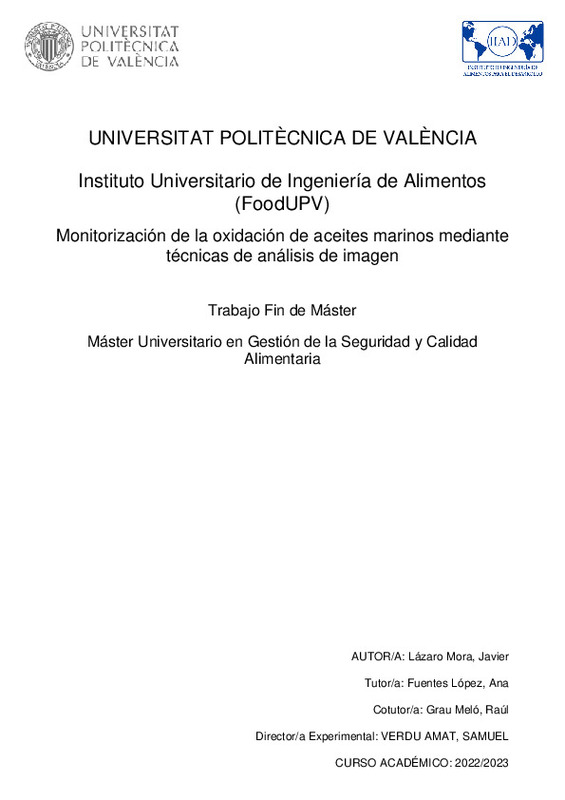|
Resumen:
|
[ES] Los aceites de origen marino son productos con un elevado valor nutricional, sin embargo, su alto contenido en ácidos grasos poliinsaturados los convierte en productos altamente susceptibles al deterioro oxidativo. ...[+]
[ES] Los aceites de origen marino son productos con un elevado valor nutricional, sin embargo, su alto contenido en ácidos grasos poliinsaturados los convierte en productos altamente susceptibles al deterioro oxidativo. Existen diferentes métodos analíticos para determinar el grado de oxidación de estos aceites, aunque estas técnicas presentan ciertos inconvenientes como su carácter destructivo de la muestra y en algunos casos baja especificidad y ejecución compleja. El objetivo del presente trabajo es evaluar el empleo de dos técnicas de análisis de imagen, dispersión láser y multiespectral, para evaluar la oxidación de diferentes aceites marinos. Para ello, muestras de aceite de hígado de bacalao y aceite de Calanus se sometieron a diferentes tratamientos térmicos (180, 200 y 220 ºC durante 5, 15 y 30 minutos). Las muestras de aceite se almacenaron a temperatura controlada y se analizaron periódicamente durante un periodo de 30 días. Durante el almacenamiento se determinaron los valores de índice de peróxidos y el valor de anisidina y se recogió la información generada por la interacción aceite-luz mediante imágenes digitales. Los resultados analíticos obtenidos evidenciaron el avance del estado de oxidación de los aceites marinos durante el almacenamiento, independientemente del tratamiento térmico aplicado. Sin embargo, las técnicas de análisis de imagen no fueron capaces de registrar estos cambios en la calidad de los aceites durante su conservación, por lo que no se considerarían técnicas adecuadas para monitorizar la calidad de estos aceites durante su conservación a temperatura ambiente.
[-]
[EN] Oils of marine origin are products with a high nutritional value, however, their high content of polyunsaturated fatty acids makes them highly susceptible to oxidative deterioration. There are different analytical ...[+]
[EN] Oils of marine origin are products with a high nutritional value, however, their high content of polyunsaturated fatty acids makes them highly susceptible to oxidative deterioration. There are different analytical methods to determine the degree of oxidation of these oils, although these techniques have certain drawbacks such as their destructive nature of the sample and in some cases low specificity and complex execution. The objective of this work is to evaluate the use of two image analysis techniques, laser and multispectral scattering, to evaluate the oxidation of different marine oils. For this, samples of cod liver oil and Calanus oil were subjected to different heat treatments (180, 200 and 220 ºC for 5, 15 and 30 minutes). The oil samples were stored at controlled temperature and analyzed periodically over a period of 30 days. During storage, the peroxide index values and the anisidine value were determined and the information generated by the oil-light interaction was collected using digital images. The analytical results obtained showed the advancement of the oxidation state of the marine oils during storage, regardless of the thermal treatment applied. However, image analysis techniques were not able to record these changes in the quality of the oils during their conservation, so they would not be considered adequate techniques to monitor the quality of these oils during their conservation at room temperature.
[-]
|







